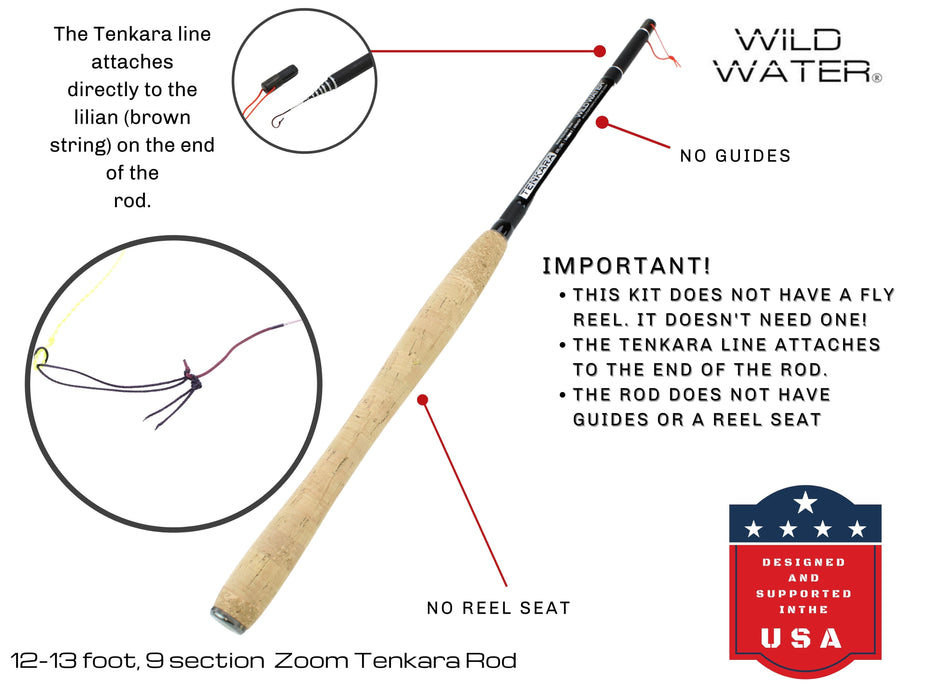What is Tenkara Fly Fishing?
Tenkara fly fishing originated in Japan hundreds of years ago, but has recently gained traction around the world for its unique approach to fly fishing. A Tenkara fly fishing setup does not use a fly reel, and instead strips down fly fishing to the bare essentials – a fly rod, line, and a fly.
The Tenkara style is an incredibly unique way to fly fish, and it has quickly become a favorite for all sorts of fly anglers. Contrary to the belief of many who have never tried Tenkara fishing, the lack of the reel is not a handicap. In fact, Tenkara fishing can sometimes be far more effective than traditional fly fishing techniques; it requires you to focus on a perfect presentation of your fly, and the delicate finesse of Tenkara makes it a great way to fish.
What's Inside a Tenkara Kit
Before we break down each component, here's a look at what you get with a Wild Water Tenkara package.
Let’s dive into the specifics on the three main components to Tenkara fishing: the rod, reel, and flies.
Tenkara Fly Rods
One important thing to understand about a Tenkara setup is that it’s not simply a normal fly fishing setup without a reel. Tenkara rods are different than traditional fly rods – primarily, they are much longer. While a standard fly rod is typically between 8 and 10 feet, Tenkara rods can get all the way up to 15 feet long.
If you’re wondering why Tenkara rods are so long, the answer is pretty simple: since you don’t have a reel to store line, you don’t have much line to work with. You won’t be able to bomb casts across a big river, so the rod length allows you to reach sections of water that you wouldn’t have been able to get to otherwise.
Casting a Tenkara rod can take some practice, as it’s a very different method of fly fishing than most people are normally used to. Once you get it down, though, it can be incredibly rewarding.
Tenkara Fly Line
Much like Tenkara rods, the line used for Tenkara can be very different than the line you’re used to on traditional fly fishing setups. To put it simply, you won’t be using the thick, rubbery floating line that is common with most fly fishing outfits; instead, Tenkara anglers use a few different types of very thin line.
Tapered furled lines and level furled lines are the two main fly line types that are commonly used with Tenkara. You could do hours of research on either of these types of line, but the bottom line is that they’re normally thin, light lines that allow you to cast well and enable a great presentation to the fish.
Tenkara Flies
Believe it or not, even many of the flies used with a Tenkara setup are specially made for this style of fishing. Don’t worry, though – you can use all of the flies that you currently have, but many Tenkara anglers choose to use special fly patterns. These special Tenkara fly patterns are typically sub-surface flies with soft hackle, which is a type of soft body material that allows the fly to look natural in the water.
When it saw its initial surge in popularity, there was a common idea that you only needed to use one fly pattern, no matter what river you were fishing. While this was common in the early days of Tenkara fishing in Japan, the truth is that there are thousands of fly patterns that will catch fish on a Tenkara setup.
Tenkara fly fishing is one of the most unique and exciting ways to fish. While it’s not necessarily for every angler or every situation, it’s a great way to fly fish, and is often a rewarding experience for those who choose to try it out!
How to set up a Tenkara rod and line
Using the Tenkara line keeping devices
Replacing a broken Tenkara rod section
Finding the lilian on a stored Tenkara rod
Freeing a stuck rod section on a Tenkara rod




























































